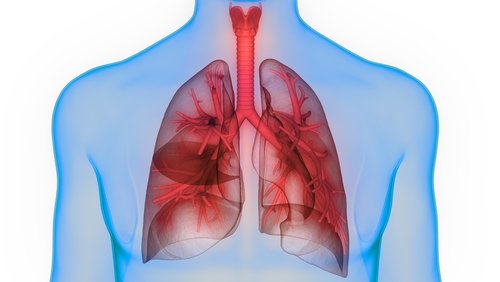Blood Levels of Fibrotic Protein Tied to SSc-ILD, May Serve as Biomarker

Higher-than-normal blood levels of squamous cell carcinoma antigen 1 (SCCA1), a pro-fibrotic protein, are associated with a greater risk of interstitial lung disease (ILD) among people with systemic sclerosis (SSc-ILD), a study suggests.
This finding points to SCCA1 blood levels as a potential biomarker for early detection of SSc-ILD, and in helping to identify scleroderma patients with a low risk of ILD. In addition, SSCA1 could be a potential therapeutic target in SSc-ILD.
The study, “Squamous cell carcinoma antigen-IgM (SCCA-IgM) is associated with interstitial lung disease in systemic sclerosis,” was published in the journal Joint Bone Spine.
ILD is a group of disorders characterized by inflammation and scarring in tissue in and around the pulmonary air sacs, hampering the lungs’ ability to transfer oxygen to the bloodstream.
While it is well-established that SSc patients are at high risk of developing ILDs, its diagnosis remains challenging due to the potential lack of symptoms in early stages of the disease.
Increasing efforts are focused on identifying potential biomarkers of early lung involvement in SSc patients, but few have been clinically confirmed so far.
SCCA1, also known as SerpinB3, is involved in inflammatory diseases and cancer. It can be detected in the blood bound to another protein called IgM (SCCA-IgM).
Higher-than-normal levels of SCCA1 are found in the lungs of people with idiopathic pulmonary fibrosis (IPF), the most common ILD, and SCCA1 levels have been associated with the extent of fibrosis and fibrotic-associated processes in IPF patients and in people with chronic liver disease.
However, whether SSCA1 plays a role in lung involvement among those with SSc remains unclear.
Researchers in Italy set out to evaluate a potential link between SCCA-IgM blood levels and clinical features of SSc patients.
They analyzed demographic and clinical data on 97 SSc patients (82 women and 15 men) followed at a single tertiary center.
Patients had a mean age of 55.4, and had lived with the disease for a median of 12 years. Most (63.9%) were classified as having limited scleroderma, and 36.1% had diffuse scleroderma.
Pulmonary involvement was measured by high resolution computed tomography (HRCT) scans and lung function tests. Heart, gastrointestinal, and skin changes were also assessed.
A cut-off value for blood levels of SCCA-IgM (higher than 200 AU/ml) was determined, based on measures made using 100 healthy people.
Results showed that 41 patients (42.3%) had ILD, which was significantly linked to diffuse SSc, severe skin involvement, poorer lung function, and the presence of autoantibodies specific for scleroderma — antibodies that wrongly attack healthy cells.
Median levels of SCCA-IgM were significantly higher in patients with ILD than those without (218 vs. 87.5 AU/ml).
When comparing patients under and above the cut-off value for SCCA-IgM, the team found that significantly more patients with higher SCCA-IgM levels had ILD and a lower total lung capacity — the volume of air in the lungs after a maximum inhalation. No differences in any other clinical features were found between the two groups.
Further analyses significantly associated higher SCCA-IgM blood levels with an ILD diagnosis, increasing by 10 times the risk of developing ILD.
Interestingly, patients with a more recent ILD diagnosis (less than three years ago) had significantly higher levels of SCCA-IgM than those living with the disease for a longer period. Researchers suggested this may be associated with the transition from an inflammatory to a fibrotic phase in the lungs of SSc patients, in which SSCA1 may have a role.
The presence of low SCCA-IgM levels in SSc patients with normal values of total lung capacity also helped to identify those with a very low risk of ILD.
“SSCA-IgM is associated with interstitial lung disease in scleroderma patients and might be used in the assessment of SSc-ILD,” the researchers wrote.






